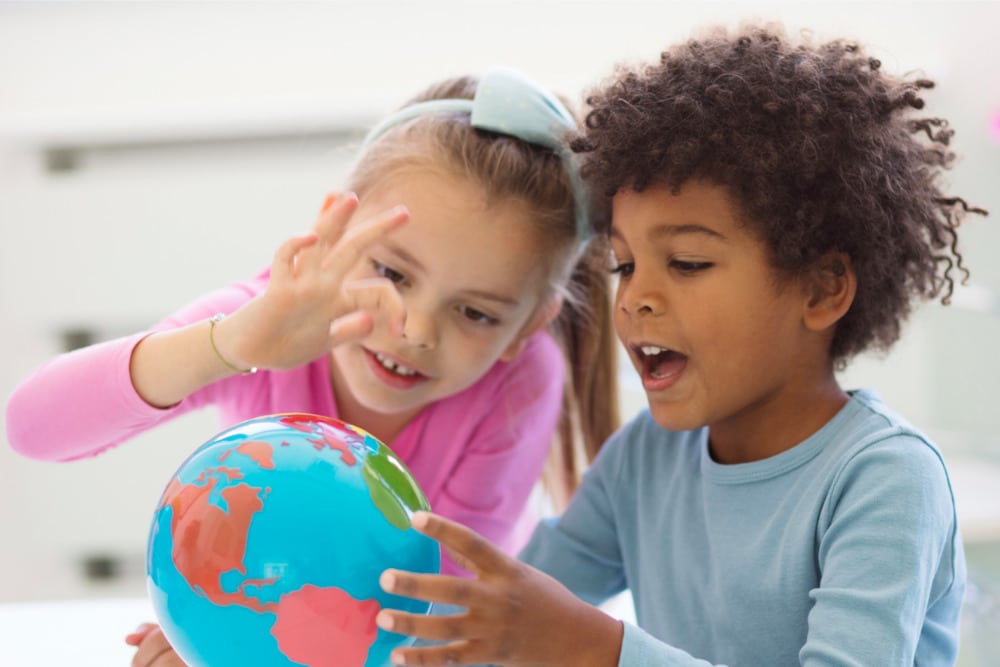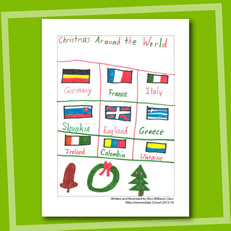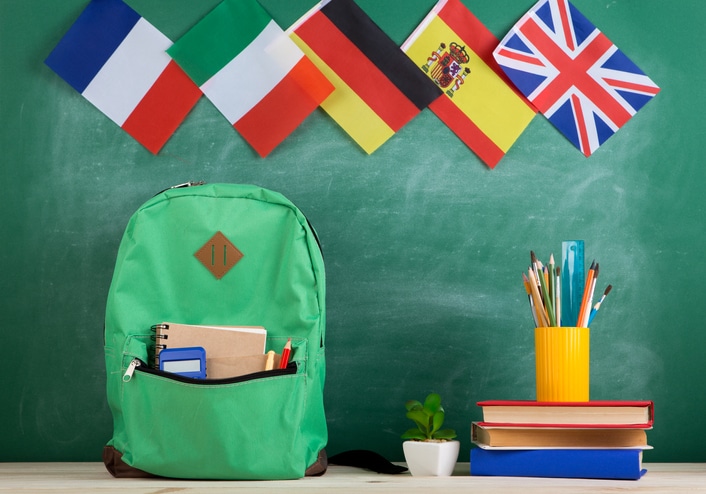 More and more, students come to class with their own unique cultures, traditions and languages. We, as teachers, must work to develop curriculum and practices that meet the needs of our diverse student populations.
More and more, students come to class with their own unique cultures, traditions and languages. We, as teachers, must work to develop curriculum and practices that meet the needs of our diverse student populations.
As your students learn more about themselves and the world around them, they’ll come to understand what makes people the same—we are all human beings with the same basic needs and feelings—as well as what makes us different and contributes to diversity—such as traditions, skin color, foods and special cultural practices.
Encourage your students to accept and celebrate differences all year long by seeing ways that you can help celebrate cultural diversity and create an inclusive classroom.
Tips for Teaching About Diversity
Self-awareness in children begins to develop when they first start to distinguish between what is “me” and what is “not me.” Around the age of two, children begin to recognize physical differences and colors, applying what they’re learning to themselves and others.
Over time, they become more aware of physical differences and go from questioning how people get different features—and wondering if they’ll change—to understanding that racial and cultural identity doesn’t change; it makes them a part of a larger group with similar characteristics.
As racial and cultural awareness develops in your students, they’ll gain a better understanding of how all of us can be (and indeed are) part of many kinds of groups, including different races, families, communities, cultures, regions and religions.
1. Provide a Variety of Resources to Broaden Understanding
Encourage your students to celebrate the different cultures represented in the classroom (or in your broader region or country, if your class is not particularly diverse) and get them excited to explore these differences.
Expanding your own cultural knowledge and sharing information with your students is a great start in helping your students understand the importance of cultural diversity. Students seeing their own culture or the cultures of their peers represented in the classroom helps promote a deeper understanding of diversity through a collection of multicultural resources. These resources could include books, music, toys, videos, movies, posters etc. and will help both you and your students to understand, honor and respect each other’s cultural differences.
2. Observe Holidays from Around the World
Holiday celebrations are wonderful opportunities for your students to learn about the beliefs, traditions and values that are important around the world.
There’s no reason to limit your class festivities to the holidays that have been most broadly or commercially celebrated in your region.
You can also focus on celebrating the seasons in your class, while learning about different holiday traditions from around the world that occur during that time.
Some holidays you may want to consider including in lesson plans are Chinese New Year; Diwali, the Hindu festival of lights; Islam’s Ramadan and Eid al-Fitr; and Latin America’s Day of the Dead.
PROJECT IDEA
The recognition and celebration of multicultural holidays makes a great class book project, too. Have each of your students focus on a different holiday tradition, then create their own page to contribute, including facts and trivia, illustrations, stories or poetry. When you’re done, you’ll have a classbook that celebrates all of the holidays your students observe which they can keep.
3. Let Each Student Explore Their Own Cultural Traditions
Help students deepen their understanding and empathy for all people by letting them explore the stories and traditions of a diversity of cultures, all while encouraging them to consider what it’s like to be in different circumstances.
Ask your students to speak with their families about common sayings or traditions in their cultures. Topics such as holiday traditions, special stories, cultural foods or even language – students might be fascinated to discover what their classmates call their grandparents, aunts and uncles, for example - are all great areas of focus. You can then have students share what they discovered with the class!
PROJECT IDEA
Have your students choose one area of their culture or heritage to focus on and interview family members or do research to learn more about the topic. Have them then write about what they learned and include information on why it is important to the culture.
Then, have your students draw a picture of what they wrote about to give others a visual aid and combine all of their work into a classbook that celebrates diversity!
Are you Enjoying this Content?
Ways to Celebrate Cultural Diversity
Now that you have an understanding of the variety of cultures represented in your class (or of the various regions and populations your students would like to learn about), it’s time to celebrate! Here are several ways you can have fun with your students exploring different cultural groups and traditions.
1. Cultural Dress Show and Tell
Have your students find pictures of different items of clothing that people wear in different cultures and groups. Some examples can include Jewish yarmulkes or Muslim burkas, which are different kinds of head coverings in these respective religious traditions.
Start with clothing that reflects the various cultures represented in your classroom—having students participate by sharing items or styles that are specific to their culture—or you can expand to even more cultures around the world, letting your students select one that interests them.
Discuss each of the items your students have shared pictures of and have your students explain why that particular item is worn in the culture it comes from and how the style or tradition originated.
2. Host a Multicultural Day
If your classroom is diverse, have your students present information on different aspects of their own cultures. If your classroom is not particularly diverse, have each of your students choose an area of the world they’d like to focus on and research. You can also concentrate on the cultures that are represented in the history of your broader area, state, or region.
Students can create brochures or posters that highlight various aspects of their diverse backgrounds, the areas their ancestors are from or the region and cultures which they chose to study. Have them present these to the class virtually or in person for your multicultural event.
Multicultural days used to involve trying foods from different cultures but since that is not ideal right now, you can have your students share a picture of a dish and recipe unique to their culture so the other students can make it at home with their parents!
3. Have a World Music Dance Party
Exploring the music of different countries and cultures is another fun way to celebrate cultural diversity in your classroom, whether in person or online.
Have students bring in (or send in digital form) music that represents their cultural heritage. Your students can also bring in or share instruments that are specific to their culture’s music.
You can use videos on the Internet to teach your students about songs and dances from different regions of the world. Have your students listen to particular instruments in the songs. Talk to them about what makes each song or dance unique: Is the music fast or slow, loud or soft? Are the movements small and subtle, or big and bold? You can even try some of the dances as a class!
Discuss with your students how people enjoy music and dance all around the globe—it’s something that human beings all have in common—while pointing out how each different group has its own particular way of singing and dancing.
Celebrate how we can experience and enjoy music from other cultures without necessarily knowing the language or cultural customs that go into it. Music is universal!
PROJECT IDEA
Have your students write about a specific type of music that either comes from their own culture or that they learned about and researched in class. They can include the history of the music, why it is significant and describe what it sounds like. Have them include an illustration of the instruments used to create the music or draw a picture of themselves dancing to the music if it is difficult to identify the instruments. Then, take their work and publish it into a musical multicultural classbook!
4. Create a Classroom Collage
As mentioned above, representation matters. And what better way to represent and celebrate your students than to display their photos in the classroom?
If you’re doing in-person learning, take photos of your students. You can also have each student bring a picture of themselves from home—sharing baby pics can be especially fun. If you’re teaching remotely, you can have children send you digital photos, or even use your computer’s screenshot feature with your distance-learning platform to “take photos” of your students with their permission of course!
Once you have pictures of all of your students, put them together in a collage. If they’ve provided both current pictures and photos from the past, you can do “then” and “now” collages. You can also add in the countries that their heritage stems from to the images.
Even if your students and their parents (or even grandparents) were born in the U.S. you can add the countries that their ancestors immigrated from if the information is available.
Display these collages prominently in your virtual or in-person classroom so that your students can literally see themselves as part of the class.
Reflections of your students in the classroom environment will foster a sense of belonging.
5. Make Global Friends
Learning about the characteristics that differentiate people all around the world is one thing, but actually meeting people from different countries and cultures is another—there is simply no substitute for connecting and interacting with people who are different from ourselves.
Use a site like ePals to pair students up with a partner from another school in a different country. Have your students send messages to their new global penpals—discussing different seasonal traditions is one great way to get students sharing and learning about one another.
Making friends from different countries and cultural groups will be an excellent way to get your students excited to learn about different world cultures.
You can schedule time for your students to have a question-and-answer session with their new partner visitor using questions your students prepare ahead of time can prove extremely engaging and insightful for everyone.
PROJECT IDEA
Have your students take the information they received from the question and answer session to compare their partner’s culture in their country to their own. They can then write out the similarities and differences that they discovered and add a drawing of themselves and their new friend doing the specific activities that they compared in their writing. You can then take all of your students’ work and create an awesome classbook that can be shared with your new friends across the globe!
Leave a comment below and let us know how you celebrate diversity in the classroom. You can also reach out to us on Facebook, Instagram or Twitter any time!
Studentreasures provides FREE classbook publishing kits. Creating a classbook is not only a fun activity that teaches students about the writing process, it can also help increase engagement and build their confidence as young writers.
Click here to learn more about how the process works and see how your students can become published authors!








